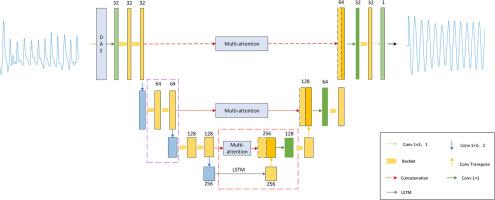Heart rate estimation for U-Net and LSTM models combining multiple attention mechanisms
IF 2.3
4区 医学
Q3 ENGINEERING, BIOMEDICAL
引用次数: 0
Abstract
Accurate heart rate (HR) monitoring is pivotal in modern medical technology, particularly for disease prevention and health management. This study proposes a novel HR estimation framework that leverages advanced deep learning techniques to accurately extract HR information from noisy photoplethysmography (PPG) signals. The proposed model, termed DRL-Unet, integrates a Denoising Autoencoder (DAE), U-Net architecture, and Long Short-Term Memory (LSTM) networks. To further enhance robustness and precision, the model incorporates a Multi-Head Attention mechanism and Residual Network (ResNet) modules. Comparative experiments demonstrate that DRL-Unet outperforms conventional deep learning models, achieving a Mean Absolute Error (MAE) of 1.69 bpm, Mean Squared Error (MSE) of 3.05 bpm², Root Mean Squared Error (RMSE) of 1.71 bpm, Mean Absolute Percentage Error (MAPE) of 1.15%, and Bias of 0.05 bpm. The model's effectiveness is validated on a public dataset from the IEEE Signal Processing Cup, confirming its superior performance under complex noise conditions. These findings highlight the potential of DRL-Unet to significantly improve the accuracy and reliability of HR estimation, thereby offering valuable advancements for early cardiovascular disease diagnosis and continuous health monitoring.

结合多注意机制的U-Net和LSTM模型的心率估计
准确的心率(HR)监测是现代医疗技术的关键,特别是对疾病预防和健康管理。本研究提出了一种新的人力资源估计框架,该框架利用先进的深度学习技术从噪声光容积脉搏波(PPG)信号中准确提取人力资源信息。该模型被称为DRL-Unet,集成了去噪自动编码器(DAE)、U-Net架构和长短期记忆(LSTM)网络。为了进一步提高鲁棒性和精度,该模型结合了多头注意机制和残余网络(ResNet)模块。对比实验表明,DRL-Unet优于传统的深度学习模型,平均绝对误差(MAE)为1.69 bpm,均方误差(MSE)为3.05 bpm²,均方根误差(RMSE)为1.71 bpm,平均绝对百分比误差(MAPE)为1.15%,偏差为0.05 bpm。该模型的有效性在IEEE信号处理杯的公共数据集上得到了验证,证实了其在复杂噪声条件下的优越性能。这些发现突出了DRL-Unet在显著提高HR估计的准确性和可靠性方面的潜力,从而为早期心血管疾病诊断和持续健康监测提供了有价值的进展。
本文章由计算机程序翻译,如有差异,请以英文原文为准。
求助全文
约1分钟内获得全文
求助全文
来源期刊

Medical Engineering & Physics
工程技术-工程:生物医学
CiteScore
4.30
自引率
4.50%
发文量
172
审稿时长
3.0 months
期刊介绍:
Medical Engineering & Physics provides a forum for the publication of the latest developments in biomedical engineering, and reflects the essential multidisciplinary nature of the subject. The journal publishes in-depth critical reviews, scientific papers and technical notes. Our focus encompasses the application of the basic principles of physics and engineering to the development of medical devices and technology, with the ultimate aim of producing improvements in the quality of health care.Topics covered include biomechanics, biomaterials, mechanobiology, rehabilitation engineering, biomedical signal processing and medical device development. Medical Engineering & Physics aims to keep both engineers and clinicians abreast of the latest applications of technology to health care.
 求助内容:
求助内容: 应助结果提醒方式:
应助结果提醒方式:


